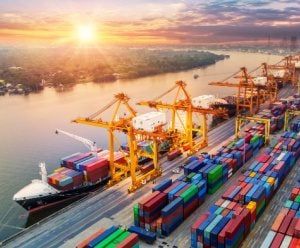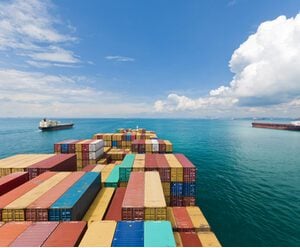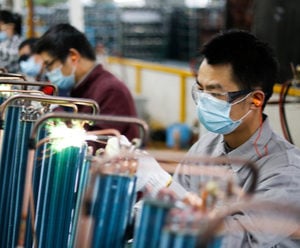
Expanding trade opportunities for Asia Pacific in a post-pandemic world

The pandemic has triggered a paradigm shift in trade growth patterns. Global trade and investment suffered an unprecedented shock as Covid-19 constrained the production and transport of many goods. Research shows that in 2020, global trade fell by 8.9 percent, the steepest drop since the 2008 global financial crisis.
Trade in goods, however, also proved remarkably resilient, and a key plank underpinning economic recovery. While goods trade fell by more than 5 percent in 2020, it bounced back by more than 10 percent in 2021.
The Asia-Pacific region has been critical to this rebound. Trade here grew almost 30 percent in the first three quarters of 2021, compared with global growth of about 28 percent, according to the Asian Development Bank (ADB).
However, a vital question is whether any pandemic-related shifts will be permanent. Can trade remain an attractive source of growth for Asia Pacific? Which countries are likely to achieve the strongest trade growth in future, and in which sectors might new growth emerge?
Asia Pacific will remain a major source of global trade growth
The overall outlook is bright for trade growth in Asia Pacific. The International Monetary Fund still describes it as the world’s most dynamic region, despite recent headwinds to economic recovery such as inflation and commodity price spillovers from the war in Ukraine.
That confidence is echoed by the ADB, which forecasts that developing economies in Asia will grow 5.2 percent in 2023, thanks to a robust recovery in domestic demand and continued export expansion.
The DHL Trade Growth Atlas 2022 tells a similar story. From the year 2000 to 2021, East Asia and Pacific has seen a tremendous trade volume growth of 271 percent, and this is set to grow even further. Based on key import and export data, the inaugural Trade Growth Atlas forecasts the Association of Southeast Asian Nations (ASEAN) will lead the world in both export and import growth over the next five years.
“ASEAN countries are looking at an annual export volume growth rate of 5.6 percent and an annual import volume growth rate of 6.6 percent, with the fastest growth over the next five years expected to be concentrated within Asia Pacific nations such as the Philippines, Vietnam, and India,” said Ken Lee, CEO, DHL Express Asia Pacific.
‘Asia-for-Asia’ trade continues to rise
New research also highlights how deepening inter-regional connections are helping strengthen resilience in Asia Pacific value chains and production networks.
For example, the ADB found that trade within the region grew 31.2 percent during 2021 alone, the biggest rise in three decades. This shift towards ‘Asia-for-Asia’ trade flows is being partly driven by manufacturers seeking to mitigate risk and insulate against additional global supply chain disruption.
“As businesses look for effective ways to address supply chain volatility, there is greater emphasis on being more resilient and designing flexible, responsive and efficient supply chain networks to cater to regional needs. The rising ‘Asia for Asia’ approach sets the stage for the growth of supply chain networks in the region,” Tim Foster, Head of Supply Chain & Logistics Advisory, Asia Pacific at Cushman & Wakefield told the Bangkok Post.
The Regional Comprehensive Economic Partnership agreement, signed between 15 Asia Pacific nations in 2020, is expected to further strengthen regional cooperation.
Ongoing lockdowns in China also mean other parts of Asia Pacific continue to benefit as global companies move away from China-centric production and sourcing strategies – a trend that began before the pandemic. Rising manufacturing hubs in Indonesia, Malaysia, Thailand, and Vietnam, for example, offer a natural alternative due to their geographic proximity.
Companies will likely continue to seek more supply chain resilience through regionalization and diversification. A recent Baker McKenzie survey of global business leaders in Asia Pacific found 73 percent of respondents are diversifying their supply chain geographies, with 42 percent pursuing a ‘China Plus One’ strategy.
India and the Philippines poised to rebound
Of course, some Asia Pacific economies are emerging from the pandemic stronger than others. India’s exports performed exceptionally well during the pandemic, bolstering recovery when other growth engines within the nation’s economy were losing steam. Ongoing export opportunities, domestic demand potential, and the country’s emergence as an attractive investment destination are all expected to help it maintain growth in the year ahead.
That view is echoed by the DHL Trade Growth Atlas 2022, which forecasts India’s trade volume growth rate will double from three to 6 percent over the next five years.
It also forecasts that trade growth in the Philippines will double from 5 percent to 10 percent during the same period. “This acceleration follows rising domestic investment and consumption as pandemic restrictions ease, allowing for more manufacturing and construction activities,” added Lee.
“Nearly all indicators point to higher growth for the Philippines this year and in 2023, barring the impact of external factors from geopolitical tensions that may dampen growth globally, including in the country’s key export markets Europe and the United States,” ADB Philippines country director, Kelly Bird, told GMA News.
Vietnam is strengthening
In economic growth terms, Vietnam is emerging as a rising star. It is the only country in the DHL Trade Growth Atlas’ top 10 of rapidly-growing countries where trade has expanded the most along two dimensions over the past five years – scale (absolute trade volume growth) as well as speed (trade volume growth rate).
That success is partly due to a business-friendly government, expanding digital ecosystem, and burgeoning economy, all of which have helped it attract major foreign players. It also reflects Vietnam’s success in becoming an important part of global value chains, developing a strong position in textiles as well as electronics.
During the first two years of the pandemic, worldwide factory shutdowns enabled electronics manufacturers in Vietnam to win more contracts. Resilient to Covid-19’s impacts, the sector moved swiftly to capitalize on this opportunity. In 2021, Vietnam’s electronics industry topped USD $36.56 billion, surging 13.6 percent year-on-year.
This also contributed to Vietnam’s overall export value rising 28.4 percent from a year earlier in the first half of 2021, further highlighting its ability to bounce back quickly from economic shocks.
E-commerce and electronics lead the way
As for the region’s fastest-growing industries, the pandemic caused an unprecedented surge in Asia Pacific e-commerce sales as retail buyers purchased goods online to avoid in-person contact. Looking ahead, the outlook for e-commerce growth remains strong. Sales are expected to nearly double by 2025, reaching USD $2 trillion, according to one estimate from Euromonitor International.
The sector is being propelled by a fast-growing base of digital consumers and merchants, an acceleration in food delivery services, and the ongoing development of digital infrastructure, including mobile connectivity. This will help the region reach a USD $1 trillion digital economy by 2030, according to research from Google, Temasek and Bain.
ASEAN is also a major export region for electronic machinery and equipment, with Singapore, the Philippines, Thailand and Vietnam recognized as global leaders in producing integrated circuits, semiconductor components, and hard drives.
The regional impact of the pandemic was initially severe. Research from Fortune shows that the semiconductor market, for example, declined 0.20 percent in 2020. But with global demand for chips still buoyant, studies are also suggesting that pandemic-related disruptions are unlikely to diminish the sector’s long-term potential. Fortune also forecasts that the semiconductor market in ASEAN will grow robustly from USD $27.64 billion in 2021 to $41.88 billion in 2028, at a compound annual growth rate of 6.1 percent during the forecast period.
New trade growth opportunities are emerging
Other growth areas could include low-carbon goods and services, an industry set to benefit as businesses and investors increasingly target long-term resilience and sustainability. Singapore is already positioning itself as a leader, building on its existing role as a growing hub for green finance and carbon services.
As the DHL Trade Growth Atlas 2022 points out, trade growth in such areas reflects a deeper trend with Asia Pacific becoming known for the quality not just the quantity of goods it produces. This will likely continue as Asia Pacific economies advance swiftly in areas such as digital connectivity and innovation.
To support economic recovery, Asia Pacific governments will need to counter headwinds such as rising inflation, as geopolitical tensions contribute to higher global oil and commodity prices.
“Despite ongoing uncertainties with world events, the region’s ability to thrive in trade growth is clear, as countries begin to recover from the pandemic,” said Lee optimistically.
ALSO WORTH READING















 English
English